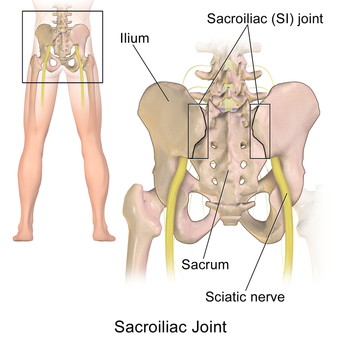 Finally! I am ready to write about the sacroiliac joint. I haven’t been as comprehensive in my research as I hoped but I have realised that trying to be perfect is stopping me from being ‘good enough’. It’s time to synthesise the information. I don’t intend to pepper my blog entries with references, although I will include some, where the idea is particularly novel or controversial. If you do want to know where I got a piece of information you can always email me. I’ll try and make these readable for those without a medical background but invariably they won’t be quite as easy as some of my other writing. This first article is about the structure of the Sacroiliac joint and how it might differ from our understanding. A quick reminder, the sacroiliac joints are paired joints between the sacrum (the triangular bone between the main spine and coccyx) and the ilia (the ilium is one of 3 bones that fuse in adulthood to form the innominate bone, the two of which form the rest of the pelvis). Clear as mud no doubt! This week’s blog entry is about the structure of the joint and next week about function but for this week’s entry to make sense it is important to discuss the fact that there has been ongoing controversy about how much movement occurs and therefore how it can go wrong. Research was very contradictory until 1940s when it was determined that they basically didn’t move and therefore couldn’t cause problems, this persisted until 1980s when that position was reversed, although there is still debate about the subject. Suffice it to say most osteopaths became heretics during that period and maintained that the joint could move, and could indeed move out of place. More of that next week. The bony structure The first surprise is how common significant asymmetry is. Not just in shape, size and orientation but also, the presence of additional non-continuous mini-joints. It is also not uncommon for there to be a midpoint inter articular tubercle (imagine this as a bony pivot), especially in men. The joint surface is a comparatively large one shaped like an ear (it is described as auricular) and is ridged, this increases the friction acting between the surfaces and acts to restrict available movement Women generally have a much smaller interarticular area which implies less and potentially insufficient friction, especially in girls aged 10-20 who notably have many more pelvic problems than men. The joint does move! Ankylosis (bony fusion) is not the norm. It almost never occurs in women and most old men maintain mobility. Where it does occur it seems to relate to lack of movement, especially in teenage years. The neuromuscularligamentous connections The sacroiliac joint is not one that can be flexed, rotated or otherwise affected at will to create significant movement (I would query maximal hip extension) and therefore is not considered to have muscles acting across it in the commonly understood sense, but there are a large number of muscles and other important soft-tissue structures which partially attach into the ligaments and capsule which surround and support the joint including iliolumbar ligament, gluteus maximus, multifidus, piriformis and in many cases hamstring muscles. They have an effect on the orientation and integrity of the joint as will be discussed in later blogs. The ligaments holding the the joint together themselves are some of the strongest in the body. Finally, nerves from the posterior sacral rami (that just means some of the nerves that exit the spinal column at the level of the sacrum) form a plexus (network) in the area of the sacroiliac joint, could they be relevant in pain in the area? So we have a large stable joint supported by very strong ligaments but it doesn't often fuse and that suggests that not only does it move but that it is meant to. the presence of muscular slips perhaps also suggests that the movement is either not entirely passive or is actively controlled and a previously under-described plexus of nerves bang smack in the area. More next week... picture Blausen.com staff (2014). "Medical gallery of Blausen Medical 2014". WikiJournal of Medicine 1 (2). DOI:10.15347/wjm/2014.010. ISSN 2002-4436. - Own work
1 Comment
Your comment will be posted after it is approved.
Leave a Reply. |
Archives
February 2024
AuthorDamian is the principal osteopath at Vauxhall Village Osteopathy and Oval Osteopathy Categories
All
|


 RSS Feed
RSS Feed


